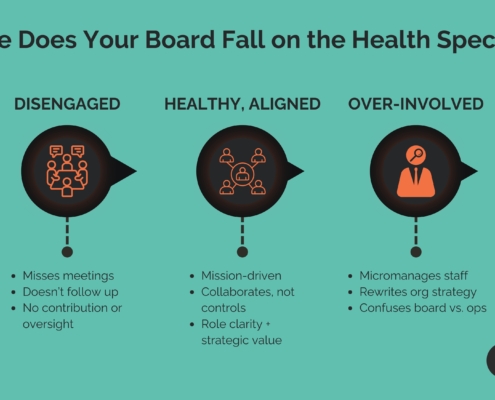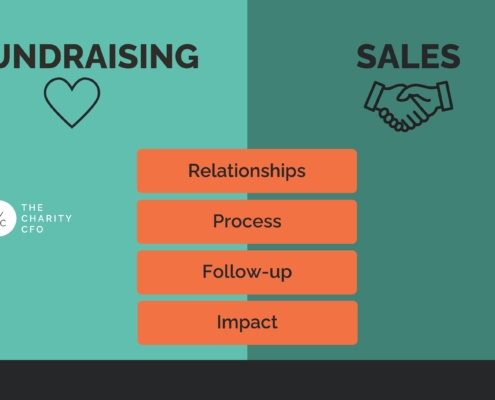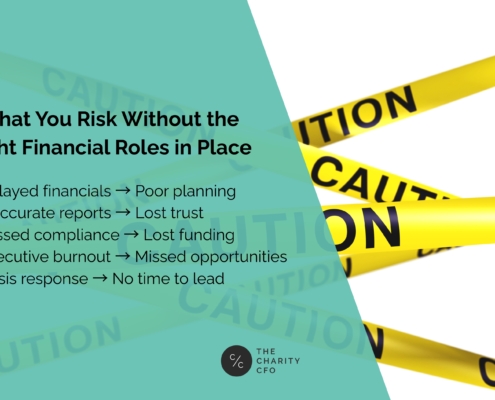 https://thecharitycfo.com/wp-content/uploads/2025/08/The-Real-Reason-Nonprofit-Budgets-Fail—And-How-to-Fix-It.jpg
1250
2000
Abstrakt Marketing
/wp-content/uploads/2025/03/fileuploads_222926_8055634_252-8e05624973e20b5de823aebdbcfd37df_LogoLeftAligned.png
Abstrakt Marketing2025-08-20 09:02:342025-10-08 07:55:25The Real Reason Nonprofit Budgets Fail—And How to Fix It
https://thecharitycfo.com/wp-content/uploads/2025/08/The-Real-Reason-Nonprofit-Budgets-Fail—And-How-to-Fix-It.jpg
1250
2000
Abstrakt Marketing
/wp-content/uploads/2025/03/fileuploads_222926_8055634_252-8e05624973e20b5de823aebdbcfd37df_LogoLeftAligned.png
Abstrakt Marketing2025-08-20 09:02:342025-10-08 07:55:25The Real Reason Nonprofit Budgets Fail—And How to Fix ItRestricted grants can feel like a win until they start draining your time, stretching your team, and straining your cash flow. These funds are intended to support your mission. But when managed without the right systems or strategy, they can quietly put your organization at risk.
In this solo episode of A Modern Nonprofit Podcast, Tosha Anderson breaks down what restricted grants are, when they can help, when they become a burden, and why releasing them quickly is essential for sustainability.
What Is a Restricted Grant?
A restricted grant is money given to your nonprofit for a specific purpose or timeframe. It may be tied to a program, an event, or a deliverable the funder has outlined. Unlike unrestricted grants, which you can use where you need them most, restricted funds are designated for something specific.
Funders often apply restrictions to ensure accountability and alignment with their own priorities. There is nothing wrong with that, but the way you handle those restrictions on your end matters a lot more than many nonprofit leaders realize.
When Restricted Grants Work in Your Favor
Restricted grants can be valuable if they are supporting programs you already operate. When the funding lines up with your strategic goals, your reporting systems are solid, and the timing fits your program cycle, these grants can help fill known budget gaps without adding much stress.
Tosha emphasizes that tracking these grants is scalable. If you have a system that works for one or two restricted gifts, it should be able to handle ten or twenty. That kind of scalability is key. It turns a potential burden into something your organization can manage with confidence.
When They Create Bigger Problems
Restricted grants become a liability when they force your organization to act outside of its strategy. This often happens when leaders chase available funding for programs they do not already run or when the restrictions are so tight they create operational problems.
One of the most common issues is cash flow. Tosha shares how many organizations are forced to front costs and wait 30, 60, or even 90 days for reimbursement. During that time, payroll still runs, rent is due, and your team feels the squeeze.
Another issue is mission drift. When organizations go after grants just because the money is there, they start adding programs or pilots that are not part of their core strategy. These additions take resources away from what really matters and stretch the staff thin.
In one example, Tosha worked with a nonprofit that had stacked grant after grant but lacked the admin support to manage them. The programs kept growing, but the operations team stayed the same size. Eventually, compliance fell behind, and the fundraising team could not close the growing budget gap. On paper, it looked like growth. In reality, it was burnout waiting to happen.
Why You Should Release Restricted Funds Promptly
One of the biggest takeaways from this episode is the importance of releasing restricted funds as soon as you are eligible to do so. Many nonprofits treat restricted funds like a savings account. Even when the money has already been used for the intended purpose, they delay lifting the restriction and keep it on the books.
Tosha explains why this is a mistake.
First, it creates a false sense of financial health. You might have restricted net assets on your balance sheet, but those dollars are not available to pay your bills or fund urgent needs.
Second, it may hurt your chances of getting future grants. If a funder sees that you still have last year’s money unspent, they may assume you did not need it and reduce or deny your next request.
Finally, holding on to restrictions makes it harder to pivot. If your program strategy shifts or your team changes, releasing those funds later can become more complicated than necessary.
What Nonprofit Leaders Should Do Now
Start by reviewing your current restricted funds. Are there dollars that should have been released but are still sitting on the books? If so, talk to your finance team and make a plan to clear them.
If you are pursuing new restricted grants, ask yourself whether your organization is prepared to manage them. Do you have the systems to track expenses? Do you understand the timing of the cash flow? Does this grant align with your existing programs?
Tosha also encourages fundraising professionals to advocate for unrestricted support whenever possible. Many times, it is possible to shape the conversation with donors and avoid unnecessary restrictions from the start.
Final Thoughts
Restricted grants are not inherently bad. But they come with strings. If your team is not ready to handle the tracking, compliance, and reporting, those strings can get tangled quickly.
If you have already met the funder’s expectations, release the dollars. Free up your cash. Improve your flexibility. And protect your relationship with the funder.
Need help setting up a better system to manage restricted funds? That is exactly what we do.
Contact The Charity CFO and let’s simplify your grant tracking, reporting, and compliance processes so you can focus on delivering impact.
Check Out These Blogs Next
Fund Accounting for Nonprofits & Charities
Building a Grant Team That Works: The 6 Roles Every Nonprofit Needs
Why Every Nonprofit Needs a Skilled Accounting Team
Follow Us Online
🌐 Website: www.thecharitycfo.com
📸 Instagram: @thecharitycfo
📘 Facebook: /thecharitycfo
💼 LinkedIn: / the-charity-cfo
🎵 TikTok: @thecharitycfo
Join our newsletter: https://go.thecharitycfo.com/l/995872/2025-02-24/6ldn1
Download The Charity CFO Financial Blueprint: https://go.thecharitycfo.com/financial-blueprint
No time to read this article now? Download it for later.
Need more than a CFO? Our bookkeeping services offer additional support, so you get full-spectrum financial leadership, all in one place.
Share This Post
More Like This
 https://thecharitycfo.com/wp-content/uploads/2025/08/The-Real-Reason-Nonprofit-Budgets-Fail—And-How-to-Fix-It.jpg
1250
2000
Abstrakt Marketing
/wp-content/uploads/2025/03/fileuploads_222926_8055634_252-8e05624973e20b5de823aebdbcfd37df_LogoLeftAligned.png
Abstrakt Marketing2025-08-20 09:02:342025-10-08 07:55:25The Real Reason Nonprofit Budgets Fail—And How to Fix It
https://thecharitycfo.com/wp-content/uploads/2025/08/The-Real-Reason-Nonprofit-Budgets-Fail—And-How-to-Fix-It.jpg
1250
2000
Abstrakt Marketing
/wp-content/uploads/2025/03/fileuploads_222926_8055634_252-8e05624973e20b5de823aebdbcfd37df_LogoLeftAligned.png
Abstrakt Marketing2025-08-20 09:02:342025-10-08 07:55:25The Real Reason Nonprofit Budgets Fail—And How to Fix It https://thecharitycfo.com/wp-content/uploads/2025/07/Should-Your-Nonprofit-Hire-a-Full-Time-or-Fractional-CFO.jpg
1250
2000
Abstrakt Marketing
/wp-content/uploads/2025/03/fileuploads_222926_8055634_252-8e05624973e20b5de823aebdbcfd37df_LogoLeftAligned.png
Abstrakt Marketing2025-07-18 14:12:352025-10-08 07:55:29Should Your Nonprofit Hire a Full-Time or Fractional CFO?
https://thecharitycfo.com/wp-content/uploads/2025/07/Should-Your-Nonprofit-Hire-a-Full-Time-or-Fractional-CFO.jpg
1250
2000
Abstrakt Marketing
/wp-content/uploads/2025/03/fileuploads_222926_8055634_252-8e05624973e20b5de823aebdbcfd37df_LogoLeftAligned.png
Abstrakt Marketing2025-07-18 14:12:352025-10-08 07:55:29Should Your Nonprofit Hire a Full-Time or Fractional CFO? https://thecharitycfo.com/wp-content/uploads/2025/07/File-35-scaled.jpg
1600
2560
Abstrakt Marketing
/wp-content/uploads/2025/03/fileuploads_222926_8055634_252-8e05624973e20b5de823aebdbcfd37df_LogoLeftAligned.png
Abstrakt Marketing2025-07-17 11:17:362025-10-08 07:55:29Operating Reserves Done Right: Planning, Policies, and Board Buy-In
https://thecharitycfo.com/wp-content/uploads/2025/07/File-35-scaled.jpg
1600
2560
Abstrakt Marketing
/wp-content/uploads/2025/03/fileuploads_222926_8055634_252-8e05624973e20b5de823aebdbcfd37df_LogoLeftAligned.png
Abstrakt Marketing2025-07-17 11:17:362025-10-08 07:55:29Operating Reserves Done Right: Planning, Policies, and Board Buy-In https://thecharitycfo.com/wp-content/uploads/2025/07/File-26-scaled.jpg
1440
2560
Abstrakt Marketing
/wp-content/uploads/2025/03/fileuploads_222926_8055634_252-8e05624973e20b5de823aebdbcfd37df_LogoLeftAligned.png
Abstrakt Marketing2025-07-17 11:08:132025-10-08 07:55:30Nonprofit Board Myths, Truths, and the Path to a Board That Works
https://thecharitycfo.com/wp-content/uploads/2025/07/File-26-scaled.jpg
1440
2560
Abstrakt Marketing
/wp-content/uploads/2025/03/fileuploads_222926_8055634_252-8e05624973e20b5de823aebdbcfd37df_LogoLeftAligned.png
Abstrakt Marketing2025-07-17 11:08:132025-10-08 07:55:30Nonprofit Board Myths, Truths, and the Path to a Board That Works https://thecharitycfo.com/wp-content/uploads/2025/07/File-2-scaled.jpg
1600
2560
Abstrakt Marketing
/wp-content/uploads/2025/03/fileuploads_222926_8055634_252-8e05624973e20b5de823aebdbcfd37df_LogoLeftAligned.png
Abstrakt Marketing2025-07-17 10:59:552025-10-08 07:55:30Fundraising vs. Sales: What I Wish I Knew about Sales When I was a Fundraiser
https://thecharitycfo.com/wp-content/uploads/2025/07/File-2-scaled.jpg
1600
2560
Abstrakt Marketing
/wp-content/uploads/2025/03/fileuploads_222926_8055634_252-8e05624973e20b5de823aebdbcfd37df_LogoLeftAligned.png
Abstrakt Marketing2025-07-17 10:59:552025-10-08 07:55:30Fundraising vs. Sales: What I Wish I Knew about Sales When I was a Fundraiser https://thecharitycfo.com/wp-content/uploads/2025/07/File-19-scaled.jpg
1440
2560
Abstrakt Marketing
/wp-content/uploads/2025/03/fileuploads_222926_8055634_252-8e05624973e20b5de823aebdbcfd37df_LogoLeftAligned.png
Abstrakt Marketing2025-07-17 10:35:042025-10-08 07:55:31Your Nonprofit Training Isn’t Working—Here’s How to Fix It
https://thecharitycfo.com/wp-content/uploads/2025/07/File-19-scaled.jpg
1440
2560
Abstrakt Marketing
/wp-content/uploads/2025/03/fileuploads_222926_8055634_252-8e05624973e20b5de823aebdbcfd37df_LogoLeftAligned.png
Abstrakt Marketing2025-07-17 10:35:042025-10-08 07:55:31Your Nonprofit Training Isn’t Working—Here’s How to Fix It https://thecharitycfo.com/wp-content/uploads/2025/07/File-32-scaled.jpg
1600
2560
Abstrakt Marketing
/wp-content/uploads/2025/03/fileuploads_222926_8055634_252-8e05624973e20b5de823aebdbcfd37df_LogoLeftAligned.png
Abstrakt Marketing2025-07-16 15:56:512025-10-08 07:55:32Top 5 Signs Your Accounting Is a Mess (And How to Fix It)
https://thecharitycfo.com/wp-content/uploads/2025/07/File-32-scaled.jpg
1600
2560
Abstrakt Marketing
/wp-content/uploads/2025/03/fileuploads_222926_8055634_252-8e05624973e20b5de823aebdbcfd37df_LogoLeftAligned.png
Abstrakt Marketing2025-07-16 15:56:512025-10-08 07:55:32Top 5 Signs Your Accounting Is a Mess (And How to Fix It) https://thecharitycfo.com/wp-content/uploads/2025/07/File-24-scaled.jpg
1600
2560
Abstrakt Marketing
/wp-content/uploads/2025/03/fileuploads_222926_8055634_252-8e05624973e20b5de823aebdbcfd37df_LogoLeftAligned.png
Abstrakt Marketing2025-07-16 15:47:152025-10-08 07:55:32Why Every Nonprofit Needs a Skilled Accounting Team
https://thecharitycfo.com/wp-content/uploads/2025/07/File-24-scaled.jpg
1600
2560
Abstrakt Marketing
/wp-content/uploads/2025/03/fileuploads_222926_8055634_252-8e05624973e20b5de823aebdbcfd37df_LogoLeftAligned.png
Abstrakt Marketing2025-07-16 15:47:152025-10-08 07:55:32Why Every Nonprofit Needs a Skilled Accounting Team https://thecharitycfo.com/wp-content/uploads/2025/07/File-37-scaled.jpg
1440
2560
Abstrakt Marketing
/wp-content/uploads/2025/03/fileuploads_222926_8055634_252-8e05624973e20b5de823aebdbcfd37df_LogoLeftAligned.png
Abstrakt Marketing2025-07-16 15:36:092025-10-08 07:55:33Building a Grant Team That Works: The 6 Roles Every Nonprofit Needs
https://thecharitycfo.com/wp-content/uploads/2025/07/File-37-scaled.jpg
1440
2560
Abstrakt Marketing
/wp-content/uploads/2025/03/fileuploads_222926_8055634_252-8e05624973e20b5de823aebdbcfd37df_LogoLeftAligned.png
Abstrakt Marketing2025-07-16 15:36:092025-10-08 07:55:33Building a Grant Team That Works: The 6 Roles Every Nonprofit Needs





